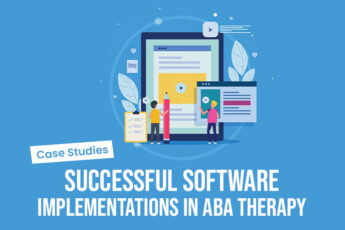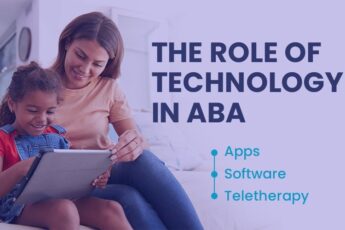Applied Behavior Analysis (ABA) therapy has made significant strides in improving the lives of individuals with autism and other developmental disabilities. The advent of telehealth has opened new doors for accessibility and flexibility, allowing ABA therapy to reach a wider audience. While the potential benefits of remote ABA therapy are vast, implementing it successfully requires careful planning and strategic execution. This blog delves into key strategies for streamlining remote ABA therapy sessions, ensuring a positive and effective experience for both clients and therapists.
1. Building a Robust Technological Foundation
A solid technological foundation is the cornerstone of a successful remote ABA therapy program. Here’s what to consider:
- Reliable Internet Connection: Both the therapist and client need stable, high-speed internet access. This minimizes interruptions and ensures clear audio and video transmission, facilitating seamless communication.
- Secure Video Conferencing Platforms: Choose a reputable video conferencing platform that prioritizes security and functionality. Options like Zoom, Google Meet, and Skype offer features like screen sharing, breakout rooms, and secure data encryption, critical for safeguarding sensitive client information.
- Interactive Tools and Resources: Engage clients and foster active participation with interactive whiteboards, online games, and visual aids. Platforms like Canva, Quizizz, and Kahoot offer engaging options for reinforcing learning concepts and making sessions more dynamic.
- Data Security Measures: Implement robust data security protocols, including password protection, encryption, and HIPAA-compliant practices, to ensure the confidentiality and integrity of client information.
2. Establishing Structure for Success
While remote therapy offers convenience, maintaining a structured approach is paramount for successful outcomes.
- Dedicated Space: Both the therapist and client should have a designated quiet space for sessions. This minimizes distractions and promotes focus, ensuring a productive therapeutic environment.
- Clear Communication Protocols: Establish clear communication protocols regarding session times, cancellations, and expectations for participation. This fosters a professional and positive environment, setting clear expectations for both parties.
- Visual Cues and Schedules: Utilize visual aids such as timers, calendars, and checklists to help clients understand session structure and progress. This is especially helpful for individuals with autism who benefit from visual clarity and predictability.
- Active Parent Involvement: Foster open communication with parents/caregivers. Regularly share progress reports, discuss any concerns, and collaborate on strategies to support the client’s learning journey. This collaborative approach ensures consistent support and addresses individual needs effectively.
3. Engaging Clients in the Virtual Space
Engaging clients in remote ABA therapy is crucial for optimal learning and progress. Employ these strategies:
- Interactive Games and Activities: Utilize online games, puzzles, and interactive activities to reinforce learning concepts and keep clients motivated. Tailor these activities to individual preferences and skill levels, ensuring enjoyment and engagement.
- Visual Supports and Social Stories: Utilize visual aids and social stories to explain procedures, expectations, and social situations. This helps clients understand and navigate social interactions, particularly in unfamiliar virtual environments.
- Positive Reinforcement and Feedback: Provide regular positive reinforcement for desired behaviors and progress. This motivates clients and strengthens their learning, fostering a sense of accomplishment and encouraging continued effort.
- Varied Learning Techniques: Combine different learning modalities, such as visual, auditory, and kinesthetic approaches, to cater to individual learning styles and maximize engagement. This caters to diverse learning preferences and ensures a comprehensive approach to learning.
4. Streamlining Data Collection and Reporting
Data collection is a crucial aspect of ABA therapy. In a remote setting, it’s essential to streamline the process for efficient analysis and reporting.
- Digital Data Collection Tools: Utilize online platforms and apps specifically designed for ABA data collection. These platforms offer features like session scheduling, real-time data entry, customizable reports, and data visualization tools, simplifying the collection and analysis process.
- Regular Reporting: Generate comprehensive progress reports regularly, sharing them with parents/caregivers and the client’s treatment team. This promotes transparency, fosters collaborative decision-making, and allows for timely adjustments to the treatment plan based on progress.
- Data Visualization: Utilize charts, graphs, and other visual aids to present data in an accessible and engaging manner. This helps clients, parents, and the therapist track progress, identify areas for improvement, and visualize the impact of therapy.
5. Tailoring the Approach to Individual Needs
Every client is unique, with distinct learning styles, preferences, and needs. Adapting remote ABA therapy to individual requirements is paramount for optimal outcomes.
- Personalized Treatment Plans: Develop individualized treatment plans based on client assessments and goals. This ensures the therapy addresses specific needs and maximizes progress, promoting personalized learning and development.
- Flexible Scheduling: Offer flexible scheduling options to accommodate individual schedules and minimize disruption to routines. This fosters a sense of control and empowers clients to actively participate in their therapy without compromising their daily schedules.
- Open Communication and Collaboration: Establish clear communication channels with clients, parents/caregivers, and other professionals involved in the client’s care. This ensures everyone is on the same page, working collaboratively toward shared goals, and fostering a unified approach to treatment.
Conclusion from DIBS Custom Software Development
At DIBS, we recognize the transformative potential of technology in advancing the field of ABA therapy. Streamlining remote ABA therapy sessions is crucial for ensuring accessible, effective, and engaging care for individuals with autism and other developmental disabilities. We are dedicated to developing innovative software solutions that empower therapists and clients to thrive in the virtual landscape. Our mission is to create intuitive and user-friendly platforms that simplify data collection, enhance communication, and foster rich, interactive therapeutic experiences. By embracing technology, we can expand the reach and impact of ABA therapy, empowering individuals to achieve their full potential and lead fulfilling lives.







Leave a Comment